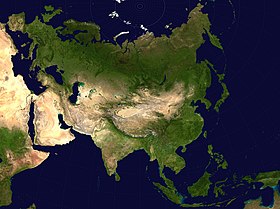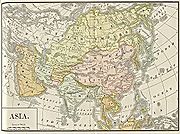Asia

Asia is the world's largest and most populous continent. It covers 8.6% of the Earth's total surface area (or 29.4% of its land area) and, with almost 4 billion people, it contains more than 60% of the world's current human population.
Chiefly in the eastern and northern hemispheres, Asia is traditionally defined as part of the landmass of Africa-Eurasia – with the western portion of the latter occupied by Europe – lying east of the Suez Canal, east of the Ural Mountains, and south of the Caucasus Mountains and the Caspian and Black Seas. It is bounded to the east by the Pacific Ocean, to the south by the Indian Ocean, and to the north by the Arctic Ocean.
Given its size and diversity, Asia – a toponym dating back to classical antiquity – is more a cultural concept incorporating a number of regions and peoples than a homogeneous, physical entity[1][2] (see Subregions of Asia, Asian people).
Etymology
The word Asia originated from the Ancient Greek word "Ασία", first attributed to Herodotus (about 440 BC) in reference to Anatolia or, for the purposes of describing the Persian Wars, to the Persian Empire, in contrast to Greece and Egypt. Herodotus comments that he is puzzled as to why three women's names are used to describe one land mass (Europa, Asia, and Libya, referring to Africa), stating that most Greeks assumed that Asia was named after the wife of Prometheus but that the Lydians say it was named after Asias, son of Cotys who passed the name on to a tribe in Sardis.
Even before Herodotus, Homer knew of a Trojan ally named Asios and elsewhere he describes a marsh as ασιος (Iliad 2, 461). The Greek term may be derived from Assuwa, a 14th century BC confederation of states in Western Anatolia. Hittite assu- = "good" is probably an element in that name.
Alternatively, the ultimate etymology of the term may be from the Akkadian word (w)aṣû(m), which means "to go outside" or "to ascend", referring to the direction of the sun at sunrise in the Middle East, and also likely connected with the Phoenician word asa meaning east. This may be contrasted to a similar etymology proposed for Europe, as being from Semitic erēbu "to enter" or "set" (of the sun). However, this etymology is considered doubtful, because it does not explain how the term "Asia" first came to be associated with Anatolia, which is west of the Semitic-speaking areas, unless they refer to the viewpoint of a Phoenician sailor sailing through the straits between the Mediterranean Sea and the Black Sea.
It is interesting to note, in Icelandic Saga, ancient Teutons separated Asia from Europe by the river Tanakvisl (or Vanakvisl), which flows into the Black Sea. Eastward across the River (in Asia), so legend tells, was a land known as Asaheim or Asaland, where dwelt Odin, chief god, in his citadel named Asgard.[Rydberg, Viktor. Teutonic Mythology: Gods and Goddesses of the Northland, London: Norroena Society, 1907. pp.33-34]]
Definition and boundaries
Medieval Europeans considered Asia as a continent – a distinct landmass. The European concept of the three continents in the Old World goes back to Classical Antiquity, but during the Middle Ages was notably due to Isidore of Sevilla (see T and O map). The demarcation between Asia and Africa (to the southwest) is the Isthmus of Suez and the Red Sea. The boundary between Asia and Europe is conventionally considered to run through the Dardanelles, the Sea of Marmara, the Bosporus, the Black Sea, the Caucasus Mountains, the Caspian Sea, the Ural River to its source, and the Ural Mountains to the Kara Sea near Kara, Russia. While this interpretation of tripartite continents (i.e., of Asia, Europe, and Africa) remains common in modernity, discovery of the extent of Africa and Asia have made this definition somewhat anachronistic. This is especially true in the case of Asia, which would have several regions that would be considered distinct landmasses if these criteria were used (for example, Southern Asia and Eastern Asia).
In the far northeast of Asia, Siberia is separated from North America by the Bering Strait. Asia is bounded on the south by the Indian Ocean (specifically, from west to east, the Gulf of Aden, Arabian Sea, and Bay of Bengal); on the east by the waters of the Pacific (including, counterclockwise, the South China Sea, East China Sea, Yellow Sea, Sea of Japan, Sea of Okhotsk, and Bering Sea); and on the north by the Arctic Ocean. Australia (or Oceania) is to the southeast.
Some geographers do not consider Asia and Europe to be separate continents,[3] as there is no logical physical separation between them.[2] Physiographically, Asia is the major eastern constituent of the continent of Eurasia – with Europe being a northwestern peninsula of the landmass – or of Africa-Eurasia: geologically, Asia, Europe, and Africa comprise a single continuous landmass (save the Suez Canal) and share a common continental shelf. Almost all of Europe and most of Asia sit atop the Eurasian Plate, adjoined on the south by the Arabian and Indian Plates, and with much of Siberia on the North American Plate.
In geography, there are two schools of thought. One school follows historical convention and treats Europe and Asia as different continents, categorizing subregions within them for more detailed analysis. The other school equates the word "continent" with a geographical region when referring to Europe, and use the term "region" to describe Asia in terms of physiography. Since, in linguistic terms, "continent" implies a distinct landmass, it is becoming increasingly common to substitute the term "region" for "continent" to avoid the problem of disambiguation altogether.
Given the scope and diversity of the landmass, it is sometimes not even clear exactly what "Asia" consists of. Some definitions exclude Turkey, the Middle East, Central Asia, and Russia while only considering the Far East, Southeast Asia and the Indian subcontinent to compose Asia[4][5], especially in the United States after World War II.[6] The term is sometimes used more strictly in reference to the Asia-Pacific region, which does not include the Middle East or Russia,[7] but does include islands in the Pacific Ocean — a number of which may also be considered part of Australasia or Oceania, although Pacific Islanders are commonly not considered Asian.[8]
'Economy
Asia has the 3rd largest GDP of all continents, after North America and Europe. As of 2007, the largest national economy within Asia, in terms of gross domestic product (PPP), is that of China followed by that of India and Japan. However, in nominal (exchange value) terms (which reflects economic reality and power), they rank as follows: Japan, China, South Korea, India, Saudi Arabia, Taiwan, Indonesia. In the late 1990s and early 2000s, the economies of China[31] and India have been growing rapidly, both with an average annual growth rate of more than 8%. Other recent very high growth nations in Asia include Pakistan, Vietnam, Mongolia, Uzbekistan and mineral rich nations such as Kazakhstan, Turkmenistan, Brunei, United Arab Emirates, Qatar, Kuwait, Saudi Arabia, Bahrain, and Oman. Historically, Japan has had the largest economy in Asia and second-largest of any single nation in the world, after surpassing the Soviet Union (measured in net material product) in 1986 and Germany in 1968. (NB: A number of supernational economies are larger, such as the EU, NAFTA or APEC). In the late 1980s and early 1990s, Japan's GDP was almost as large (current exchange rate method) as that of the rest of Asia combined. In 1995, Japan's economy nearly equalled that of the USA to tie as the largest economy in the world for a day, after the Japanese currency reached a record high of 79 yen. Economic growth in Asia since World War II to the 1990s had been concentrated in quite a few countries of the Pacific Rim. (Thailand, Malaysia, Singapore, Hong Kong, Taiwan, Japan, and S.Korea)
It is expected that China will surpass Japan to have the largest nominal and PPP-adjusted GDP in Asia within a decade. India may overtake Japan by 2030.
Natural resources
Asia is the largest continent in the world by a considerable margin, and it is rich in natural resources, such as petroleum and forests.
Manufacturing
Manufacturing in Asia has traditionally been strongest in East and Southeast Asia, particularly in China, Taiwan, Japan, South Korea and Singapore. Japan and South Korea continue to dominate in the area of multinational corporations, but increasingly China, Taiwan, and India are making significant inroads. Many companies from Europe, North America, and Japan have operations in Asia's developing countries to take advantage of its abundant supply of cheap labour and relatively developed infrastructure.
Financial and other services
Asia has three main financial centres: Hong Kong, Singapore, and Tokyo. Call centres and business process outsourcing (BPOs) are becoming major employers in India and the Philippines due to the availability of a large pool of highly-skilled, English-speaking workers. The increased use of outsourcing has assisted the rise of India and China as financial centres. Due to its large and extremely competitive information technology industry.
Early history
The history of Asia can be seen as the distinct histories of several peripheral coastal regions: East Asia, South Asia, and the Middle East, linked by the interior mass of the Central Asian steppes.
The coastal periphery was home to some of the world's earliest known civilizations, each of them developing around fertile river valleys. The civilizations in Mesopotamia, the Indus Valley, and the Yangtze shared many similarities. These civilizations may well have exchanged technologies and ideas such as mathematics and the wheel. Other innovations, such as writing, seem to have been developed individually in each area. Cities, states, and empires developed in these lowlands.
The central steppe region had long been inhabited by horse-mounted nomads who could reach all areas of Asia from the steppes. The earliest postulated expansion out of the steppe is that of the Indo-Europeans, who spread their languages into the Middle East, South Asia, and the borders of China, where the Tocharians resided. The northernmost part of Asia, including much of Siberia, was largely inaccessible to the steppe nomads, owing to the dense forests, climate, and tundra. These areas remained very sparsely populated.
The center and the peripheries were mostly kept separated by mountains and deserts. The Caucasus and Himalaya mountains and the Karakum and Gobi deserts formed barriers that the steppe horsemen could cross only with difficulty. While the urban city dwellers were more advanced technologically and socially, in many cases they could do little in a military aspect to defend against the mounted hordes of the steppe. However, the lowlands did not have enough open grasslands to support a large horsebound force; for this and other reasons, the nomads who conquered states in China, India, and the Middle East often found themselves adapting to the local, more affluent societies.


